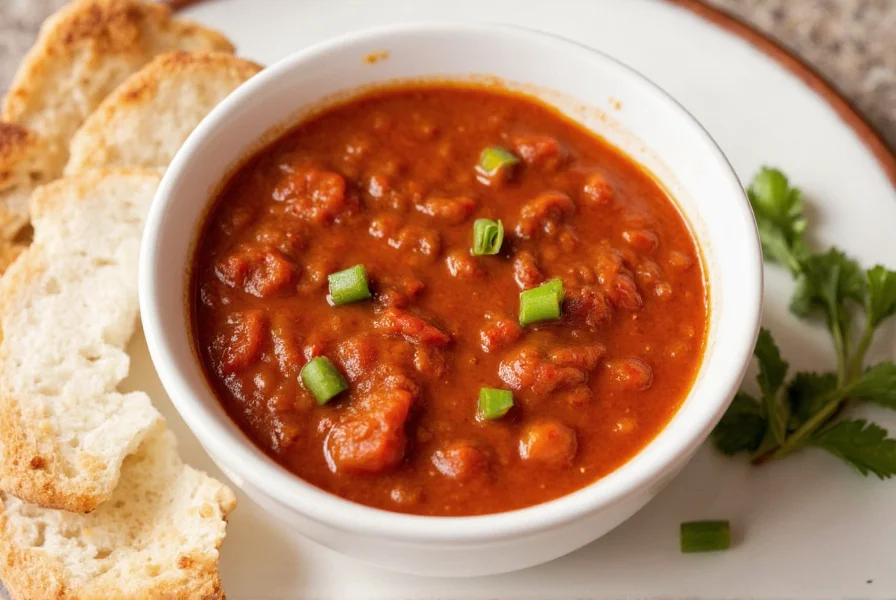Understanding the calorie content of chili is essential for those tracking nutritional intake or managing dietary goals. This comprehensive guide examines the nutritional profile of chili from multiple angles, providing accurate information to help you make informed food choices.
Nutritional Breakdown of Standard Beef Chili
Chili's calorie count varies significantly based on preparation methods and ingredients. The primary factors affecting caloric content include protein sources, bean varieties, and additional components like cheese or sour cream toppings.
| Chili Type | Calories (per 1-cup serving) | Protein (g) | Fat (g) | Carbohydrates (g) |
|---|---|---|---|---|
| Traditional Beef Chili | 280-350 | 18-22 | 12-18 | 25-30 |
| Turkey Chili | 220-280 | 20-24 | 8-12 | 26-32 |
| Vegetarian Bean Chili | 200-260 | 12-16 | 3-7 | 38-45 |
| Chili with Beans (canned) | 180-240 | 9-12 | 2-5 | 32-38 |
Factors That Influence Chili Calorie Count
Several key elements determine the final calorie content of your chili:
Protein Source Selection
The type of meat significantly impacts the calorie profile. Ground beef (80% lean) contributes approximately 250 calories per 4 ounces, while leaner options like ground turkey (93% lean) provide around 180 calories for the same portion. Vegetarian versions using beans and lentils typically range from 110-150 calories per cup of cooked legumes.
Bean Varieties and Quantities
Beans add both fiber and carbohydrates to chili. A cup of cooked kidney beans contains about 225 calories, while black beans provide approximately 227 calories. The quantity of beans used directly affects the overall calorie count—adding an extra cup of beans increases the total by roughly 225 calories distributed across servings.
Toppings and Additives
Common chili toppings substantially alter the nutritional profile:
- Sour cream (2 tablespoons): 50 calories
- Shredded cheddar cheese (1 ounce): 110 calories
- Avocado (1/4 medium): 80 calories
- Corn chips (1 ounce): 140 calories
Health Benefits Beyond Calorie Count
Chili offers several nutritional advantages that extend beyond simple calorie considerations. The combination of lean protein, dietary fiber from beans, and antioxidant-rich spices creates a nutritionally dense meal. Capsaicin, the compound that gives chili peppers their heat, has been associated with potential metabolic benefits according to research published in the International Journal of Obesity.
Homemade chili typically provides superior nutritional value compared to canned varieties, which often contain added sodium and preservatives. Preparing chili in large batches allows for portion control and convenient healthy meal options throughout the week.
Creating Lower-Calorie Chili Options
You can significantly reduce the calorie content of chili while maintaining flavor and satisfaction:
Smart Ingredient Substitutions
- Replace half the ground beef with lean ground turkey or plant-based crumbles
- Use extra beans instead of additional meat for more fiber and less fat
- Add chopped mushrooms to increase volume with minimal calories
- Choose low-sodium tomato products to control sodium content
Cooking Techniques for Healthier Chili
After browning meat, drain excess fat thoroughly before adding other ingredients. Simmering chili uncovered allows some liquid to evaporate, concentrating flavors without adding extra ingredients. Using aromatic vegetables like onions, garlic, and bell peppers enhances flavor complexity without significant calorie addition.

Chili in Different Dietary Approaches
Chili adapts well to various dietary patterns when properly modified:
- Keto dieters can enjoy chili by reducing beans and increasing healthy fats
- Mediterranean diet followers might incorporate more vegetables and lean proteins
- Plant-based eaters create satisfying versions using multiple bean varieties and textured vegetable protein
Portion control remains essential regardless of dietary approach. A standard serving size of chili is one cup, which provides adequate protein and fiber to promote satiety without excessive calorie intake.
Common Misconceptions About Chili and Calories
Several myths persist about chili's nutritional profile. Many believe all chili is high in fat, but properly prepared versions can be lean and nutritious. Others assume vegetarian chili is always lower in calories, but bean-heavy versions can sometimes exceed meat-based options in carbohydrate content.
Understanding chili nutrition facts per serving helps dispel these misconceptions. The reality is that chili's nutritional value depends entirely on the specific recipe and preparation methods used.
Practical Tips for Tracking Chili Calories
When preparing homemade chili, calculate the total recipe calories then divide by the number of servings. For restaurant or canned chili, check available nutrition information or use food tracking apps with comprehensive databases. Remember that portion sizes significantly impact actual calorie consumption—what seems like one serving might actually be two based on standard measurements.
Frequently Asked Questions
How many calories in a bowl of chili from a restaurant?
Restaurant chili typically contains 350-550 calories per standard serving (1.5-2 cups), with significant variation based on preparation style, meat fat content, and added toppings. Chain restaurants often provide nutrition information online for specific menu items.
Is chili good for weight loss?
Chili can support weight loss when prepared with lean proteins, ample vegetables, and controlled portions. Its high protein and fiber content promotes satiety, helping reduce overall calorie intake. A 1-cup serving of well-prepared chili typically provides 20-25 grams of protein and 10-15 grams of fiber, making it a satisfying meal option for weight management.
What's the lowest calorie chili option?
The lowest calorie chili option is a vegetarian version made with multiple bean varieties, lean protein like turkey breast, and minimal added fats. A cup of this preparation can contain as few as 180-220 calories while providing 15+ grams of protein and 12+ grams of fiber. Avoiding high-calorie toppings like cheese and sour cream further reduces the calorie count.
Does bean chili have fewer calories than meat chili?
Not necessarily. While beans are lower in fat than many meats, they contain more carbohydrates. A cup of bean chili typically ranges from 200-260 calories, while lean meat chili can be similar at 220-280 calories. The specific ingredients and proportions determine the final calorie count more than the simple meat vs. bean distinction.











 浙公网安备
33010002000092号
浙公网安备
33010002000092号 浙B2-20120091-4
浙B2-20120091-4